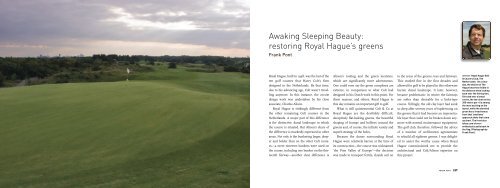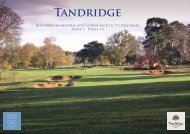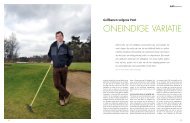restoring Royal Hague's greens - Infinite Variety Golf Design
restoring Royal Hague's greens - Infinite Variety Golf Design
restoring Royal Hague's greens - Infinite Variety Golf Design
You also want an ePaper? Increase the reach of your titles
YUMPU automatically turns print PDFs into web optimized ePapers that Google loves.
Awaking Sleeping Beauty:<br />
<strong>restoring</strong> <strong>Royal</strong> Hague’s <strong>greens</strong><br />
Frank Pont<br />
<strong>Royal</strong> Hague, built in 1938, was the last of the<br />
ten golf courses that Harry Colt’s firm<br />
designed in the Netherlands. By that time,<br />
due to his advancing age, Colt wasn’t travelling<br />
anymore. In this instance, the on-site<br />
design work was undertaken by his close<br />
associate, Charles Alison.<br />
<strong>Royal</strong> Hague is strikingly different from<br />
the other remaining Colt courses in the<br />
Netherlands. A major part of this difference<br />
is the distinctive, dunal landscape in which<br />
the course is situated. But Alison’s share of<br />
the difference is markedly expressed in other<br />
areas. Not only is the bunkering larger, deeper<br />
and bolder than on the other Colt courses—a<br />
mere nineteen bunkers were used on<br />
the course, including one bunker on the thirteenth<br />
fairway—another clear difference is<br />
Alison’s routing and the green locations,<br />
which are significantly more adventurous.<br />
One could even say the green complexes are<br />
extreme, in comparison to what Colt had<br />
designed in his Dutch work to this point. For<br />
these reasons, and others, <strong>Royal</strong> Hague to<br />
this day remains an important gift to golf.<br />
What is still quintessential Colt & Co at<br />
<strong>Royal</strong> Hague are the devilishly difficult,<br />
deceptively flat-looking <strong>greens</strong>, the beautiful<br />
shaping of humps and hollows around the<br />
<strong>greens</strong> and, of course, the infinite variety and<br />
superb strategy of the holes.<br />
Because the dunes surrounding <strong>Royal</strong><br />
Hague were relatively barren at the time of<br />
its construction—the course was nicknamed<br />
‘the Pine Valley of Europe’—the decision<br />
was made to transport fertile, clayish soil on<br />
to the areas of the <strong>greens</strong>, tees and fairways.<br />
This worked fine in the first decades and<br />
allowed for golf to be played in this otherwise<br />
barren dunal landscape. It later, however,<br />
became problematic: in winter the fairways<br />
are softer than desirable for a links-type<br />
course. Tellingly, the old clay layer had sunk<br />
so deep after seventy years of topdressing on<br />
the <strong>greens</strong> that it had become an impenetrable<br />
layer that could not be broken down anymore<br />
with normal maintenance equipment.<br />
The golf club, therefore, followed the advice<br />
of a number of well-known agronomists<br />
to rebuild all eighteen <strong>greens</strong>. I was delighted<br />
to assist the worthy cause when <strong>Royal</strong><br />
Hague commissioned me to provide the<br />
architectural and Colt/Alison expertise on<br />
this project.<br />
OPPOSITE <strong>Royal</strong> Hague <strong>Golf</strong><br />
& Country Club, The<br />
Netherlands: On a clear<br />
day, the skyline of The<br />
Hague becomes visible in<br />
the distance when looking<br />
back over the third green.<br />
Directed over a broad<br />
ravine, the tee-shot on this<br />
350-metre par-4 is among<br />
the most exciting on the<br />
layout, while the elevated<br />
green has a treacherous<br />
front that ‘swallows’<br />
approach shots that come<br />
up short. The front also<br />
takes care of overenthusiastic<br />
putts back to<br />
the flag. (Photograph by<br />
Frank Pont.)<br />
FRANK PONT 237
<strong>Royal</strong> Hague: This aerial<br />
of <strong>Royal</strong> Hague was taken<br />
just after WW2, and it shows<br />
the routing of the course<br />
through the barren dunes.<br />
Close study indicates that<br />
very little has changed to<br />
the basic layout of the<br />
holes over the years. (First<br />
published in <strong>Golf</strong> magazine.)<br />
BELOW <strong>Royal</strong> Hague:<br />
A 1938 picture taken during<br />
the ‘grow-in’ phase of the<br />
course, showing the sandy<br />
wilderness surrounding the<br />
230-metre par-3 fourth<br />
hole. Note the penal waste<br />
area in front of the green,<br />
forcing the weaker players<br />
to play a safe lay-up shot.<br />
(First published in <strong>Golf</strong><br />
magazine.)<br />
My goals at <strong>Royal</strong> Hague were two-fold:<br />
firstly, to restore the thirteen <strong>greens</strong> that were<br />
still original as accurately as possible; secondly,<br />
to create putting surfaces for the five<br />
<strong>greens</strong> that had been changed or moved over<br />
the years, so they’d look and play like original<br />
Alison <strong>greens</strong> to knowledgeable visitors. To<br />
this end, all the <strong>greens</strong> were painstakingly<br />
detailed measured in 3D, thereby allowing us<br />
to rebuild them in exactly the same form.<br />
Two further elements were instrumental<br />
in recreating Alison’s style at <strong>Royal</strong> Hague.<br />
Firstly, to mirror his large, sand-faced <strong>greens</strong>ide<br />
bunkers we studied old aerial pictures of<br />
the course to determine their exact locations<br />
and contouring. Although the bunkers are<br />
rather large and ‘in your face’, we decided to<br />
stick with this peculiar historic style rather<br />
than opt for more organic-looking bunkers.<br />
Secondly, historical analysis of the grassy<br />
hollows (with short grass) that he carefully<br />
positioned around his <strong>greens</strong> was instructive.<br />
These had become overgrown and filled-in<br />
over the years; we made a concerted effort<br />
to bring these important ‘hazards’ back<br />
into play.<br />
LEFT <strong>Royal</strong> Hague: This rendering of <strong>Royal</strong><br />
Hague’s course routing shows its compact<br />
nature—a feature the casual visitor isn’t<br />
likely to notice during their round, due to the<br />
clever way Allison weaved the sequence of<br />
holes through the dunes. (First published in<br />
<strong>Golf</strong> magazine.)<br />
BELOW <strong>Royal</strong> Hague: The singular green of<br />
the sixth hole bares its ‘teeth’, on account<br />
of a deep, grassy hollow on the right, and<br />
an ‘even’ bunker on the left. The 430-metre<br />
par-4 hole, in most cases, forces players to<br />
hit long-irons or metal/woods into the<br />
prevailing wind to this rather unreceptive<br />
green. The hole also holds the distinction<br />
of being undeniably the hardest hole in the<br />
Netherlands. It also happens to be Kyle<br />
Phillips’s favourite golf hole, worldwide.<br />
(Photograph by Frank Pont.)<br />
238 GOLF ARCHITECTURE: A WORLDWIDE PERSPECTIVE – VOLUME FIVE
OPPOSITE ABOVE LEFT<br />
<strong>Royal</strong> Hague: A view of the<br />
devilish, short-mown grassy<br />
hollows behind the 355-<br />
metre par-4 second hole’s<br />
new green. They are prime<br />
examples of the type of<br />
‘hazard’ that Colt and Alison<br />
were keen to utilise; namely,<br />
being difficult enough for<br />
good players and ‘forgiving’<br />
for less-talented golfers.<br />
(Photograph by Frank Pont.)<br />
OPPOSITE ABOVE RIGHT<br />
<strong>Royal</strong> Hague: The green of<br />
the 328-metre par-4 ninth<br />
hole lies high atop a dune<br />
ridge, guarded by a<br />
deceptively difficult bunker.<br />
The unpredictable wind is<br />
always a vital factor in<br />
choosing one’s club for the<br />
approach. (Photograph by<br />
Frank Pont.)<br />
OPPOSITE BELOW <strong>Royal</strong> Hague:<br />
The green of the 202-metre<br />
par-3 fourth hole, as seen<br />
from the back tees, still<br />
provides players with a<br />
breathtaking view of the<br />
dunes and, occasionally,<br />
passing ships on the North<br />
Sea. It doesn’t, however,<br />
diminish the threat posed by<br />
the three bunkers, or the<br />
OOB along the right-hand<br />
side of the hole. (Photograph<br />
by Frank Pont.)<br />
In <strong>restoring</strong> the original <strong>greens</strong> we took<br />
great care to recreate the exact playing surfaces;<br />
we also repaired some areas that had<br />
clearly changed over the years. One example<br />
was an enclosed depression in the thirteenth<br />
green that clearly was the result of consolidation<br />
of the soil over the previous decennia.<br />
Restoring the original <strong>greens</strong> was rewarding;<br />
the highlight of our project, however, was<br />
designing and building the new ones. The<br />
following text describes some of the thoughts<br />
and issues that went into that process.<br />
The first of the newly constructed <strong>greens</strong><br />
was on the second hole. The previous green<br />
had been very small: all upward-sloping, and<br />
it had a ‘band-like’ dune behind it that<br />
appeared artificial. The hole is a mediumlength<br />
par-4 where, due to a massive valley in<br />
front of the green, the shot into the green is<br />
either approached ‘blindly’ with a short-iron,<br />
or to a visible target with a medium-length<br />
iron. The goal was to give the player hitting<br />
into the green with the longer shot more<br />
room to land on the green, while making the<br />
longer hitter’s ‘blind’ wedge shot into the<br />
green an even harder proposition. Another<br />
goal was to remove as much visual backdrop<br />
to the green as possible, so that better players<br />
would have a hard time judging the distance<br />
to the green.<br />
The new green we built was almost fifty<br />
per cent larger. The front of the green<br />
remained the old surface, while a new back<br />
section was added—flat for the first portion,<br />
sloping away from the player, thereafter.<br />
Grassy hollows were installed behind the<br />
green.<br />
Another new green was installed at the<br />
seventh hole, where the main problem again<br />
was that the green was too small. The solution<br />
here was to lower the green surface by<br />
about a metre, which created just enough<br />
extra space on the right side to make the total<br />
green surface large enough. A welcome, extra<br />
dimension of expanding the green to the<br />
right has become apparent: it makes the teeshot<br />
even more strategic, for any drive that is<br />
not sufficiently leftward on the fairway, leaves<br />
a daunting ‘blind’ shot to the green.<br />
<strong>Royal</strong> Hague’s thirteenth green provided<br />
quite a different challenge. The supplanted<br />
green was grossly out of character with its<br />
two-tiered structure and double-flanking<br />
bunkering left and right of the green—clear<br />
indications that it wasn’t an original green.<br />
Because the hole is a difficult par-4 that is<br />
usually played into the wind, we were keen to<br />
provide players with more space to land a<br />
long-iron on the green, and to improve the<br />
odds of golf balls staying on the surface. This<br />
was achieved by moving the green rearward,<br />
making it significantly longer in the process.<br />
The new green is defended by a bunker on<br />
the front, right side and flanked on the left by<br />
a little ‘nasty’ hump at the entrance to the<br />
green. The entire left-hand side and back of<br />
the green is defended by three, huge grassy<br />
hollows that gather most of the less-accurate<br />
shots of the players. Putting on this long,<br />
upward-sloping green is far from easy, since<br />
it plays ‘tricks’ with your eyes—from both the<br />
front and the rear of the green, it seems the<br />
green slopes to the left. Obviously, this is a<br />
physical impossibility.<br />
The sixteenth hole is a short par-4, which,<br />
from the men’s tee, is driveable for the bighitters.<br />
The green had a large pine tree right<br />
next to the green, which many members<br />
liked, but it wasn’t present when the course<br />
was built. It certainly didn’t fit Alison’s design<br />
philosophy. The most negative aspect of it<br />
240 GOLF ARCHITECTURE: A WORLDWIDE PERSPECTIVE – VOLUME FIVE
<strong>Royal</strong> Hague: The 462-metre<br />
par-5 first hole plays a lot<br />
shorter than its distance would<br />
indicate; its green is also one of<br />
the more ‘friendly’ on the<br />
course—the hallmarks of a<br />
typical Alison-style opening<br />
hole. The fourth green shares a<br />
deep, grassy hollow with the<br />
first hole. (Photograph by<br />
Frank Pont.)<br />
OPPOSITE <strong>Royal</strong> Hague:<br />
Defined by a ‘blind’ tee-shot<br />
over a towering dune to a wide<br />
fairway, the 345-metre par-4<br />
seventh hole is the kind that<br />
isn’t built anymore. Don’t be<br />
fooled by the hole’s width:<br />
successful tee-shot positioning<br />
is everything here, enabling<br />
golfers to attack the flag. This<br />
especially holds sway when the<br />
pin is on the new, expanded<br />
right-hand side of the green.<br />
(Photograph by Frank Pont.)<br />
was being a perennial maintenance nightmare<br />
for the greenkeepers. We decided the<br />
tree had to go, and that it would be replaced<br />
by a new bunker, which also would increase<br />
the number of <strong>greens</strong>ide bunkers to three. To<br />
further amplify the interest of the hole, the<br />
valley situated before the green was widened.<br />
In this manner, shots into the green that were<br />
short, including drives, would roll all the way<br />
down to the right of the fairway. From this<br />
area, recovery shots can be delicate, tricky or<br />
downright murderous depending on one’s<br />
short game skill.<br />
The final par-3 of the course, the seventeenth<br />
hole, represents the last of <strong>Royal</strong><br />
Hague’s new <strong>greens</strong>. The hole suffered<br />
through having its previous green poorly visible<br />
from the tee; it didn’t assimilate in the<br />
existing landscape, and the green only yielded<br />
a few interesting pin positions. In designing<br />
the new green, along with its surrounding<br />
landforms, we wanted to achieve a number of<br />
outcomes: the front part of the green should<br />
be sloping upward to enhance visibility from<br />
the tee; the back-left part of the green should<br />
be lower than the top plateau to create a hardto-hit<br />
target; it should be more harmonious<br />
with the surrounding landscape. Lastly, we<br />
wanted to incorporate three bunkers, each<br />
with various degrees of difficulty and flashedsand<br />
faces, to make the defence of the hole<br />
more varied. Additional strengthening of the<br />
hole was achieved after we constructed a<br />
number of low, grassy hollows behind, and to<br />
the right of, the green. And last, but not of<br />
least importance, we allowed for a less-risky<br />
‘bail-out’ area for the benefit of older members<br />
in the front, left of the green. Now, a relatively<br />
easy chip onto the green is possible.<br />
The fortitude that <strong>Royal</strong> Hague displayed<br />
in having all its <strong>greens</strong> restored has paid off<br />
handsomely. Not only are the putting surfaces<br />
back to their original high standards<br />
and presenting firm and fast <strong>greens</strong>, but<br />
there is real excitement around the club<br />
knowing that it now possesses one of the<br />
most exciting inward nine holes one could<br />
ever hope to play. The ‘sleeping beauty’ that<br />
Alison created has truly woken up; may she<br />
live a long and happy life.<br />
242 GOLF ARCHITECTURE: A WORLDWIDE PERSPECTIVE – VOLUME FIVE
<strong>Royal</strong> Hague: Another<br />
long par-3, the 209-metre<br />
eighth hole requires a<br />
precise tee-shot to keep<br />
the ball on the green. The<br />
upside of a ‘missed’ green<br />
is the infinite variety of<br />
exciting recovery shots<br />
one is presented with in<br />
trying to scramble a par.<br />
(Photograph by Frank<br />
Pont.)<br />
OPPOSITE ABOVE<br />
<strong>Royal</strong> Hague: The new<br />
row of bunkers, allied to<br />
the enlarged valley in<br />
front of the green of the<br />
261-metre par-4 sixteenth<br />
hole, makes any effort to<br />
drive the green both<br />
exciting and potentially<br />
dangerous to your score.<br />
A great match play hole; it<br />
comes at exactly the right<br />
moment in the round at<br />
<strong>Royal</strong> Hague. (Photograph<br />
by Frank Pont.)<br />
OPPOSITE BELOW<br />
<strong>Royal</strong> Hague: The last of<br />
the par-3s, the 143-metre<br />
seventeenth is another<br />
hole that offers the player<br />
with numerous tee-shot<br />
options. The hole’s<br />
defense is its three<br />
bunkers, and the front and<br />
back-sloping areas of the<br />
green, subjecting players<br />
to pin positions that vary<br />
from ‘easy’ to ‘impossible’.<br />
Always, however, the<br />
astute player can find a<br />
way to avoid trouble, be it<br />
at the loss of a stroke.<br />
(Photograph by Frank<br />
Pont.)
<strong>Royal</strong> Hague: The green<br />
of the 403-metre par-4<br />
eleventh hole has a deep,<br />
‘bathtub’-style hollow in its<br />
front entrance that eludes<br />
approach shots that are<br />
slightly inaccurate—a design<br />
element that was a favourite<br />
of Colt & Co. Behind the<br />
green, grassy hollows were<br />
reinstated during the works.<br />
(Photograph by Frank Pont.)<br />
BELOW LEFT<br />
<strong>Royal</strong> Hague: Even though<br />
the par-3 twelfth hole has<br />
the largest green of the<br />
course, and it only measures<br />
158 metres, an alwaysshifting<br />
side wind makes this<br />
one of the hardest <strong>greens</strong> to<br />
hit in regulation. Several<br />
deep, grassy hollows make<br />
the resulting up-and-down<br />
shots both interesting and<br />
tricky. (Photograph by<br />
Frank Pont.)<br />
BELOW RIGHT<br />
<strong>Royal</strong> Hague: The new<br />
thirteenth green now sees<br />
the 397-metre par-4 as being<br />
almost as challenging as the<br />
sixth hole. Not only is the<br />
green well-defended by<br />
grassy hollows and a bunker,<br />
it’s bolstered by a hump at its<br />
entrance, which serves to<br />
push slightly inaccurate<br />
shots both left and right.<br />
(Photograph by Frank Pont.)<br />
OPPOSITE<br />
<strong>Royal</strong> Hague: The severely<br />
undulating tenth fairway and<br />
the hole’s contrasting green,<br />
as seen from the right-hand<br />
side of the fairway. From this<br />
photo’s general vicinity,<br />
long-hitters usually attempt<br />
to reach the green of this<br />
439-metre par-5.<br />
(Photograph by Frank Pont.)









